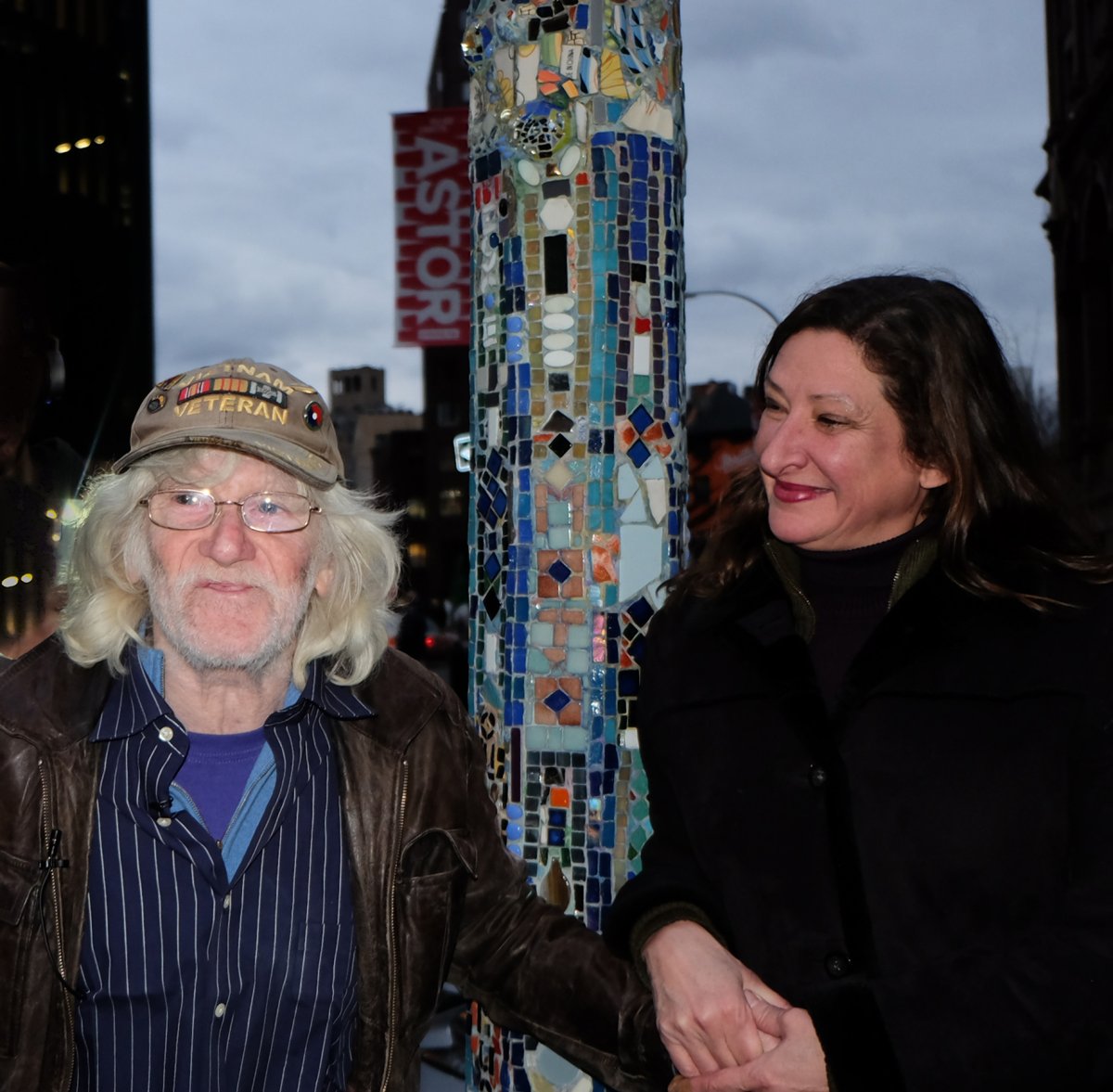
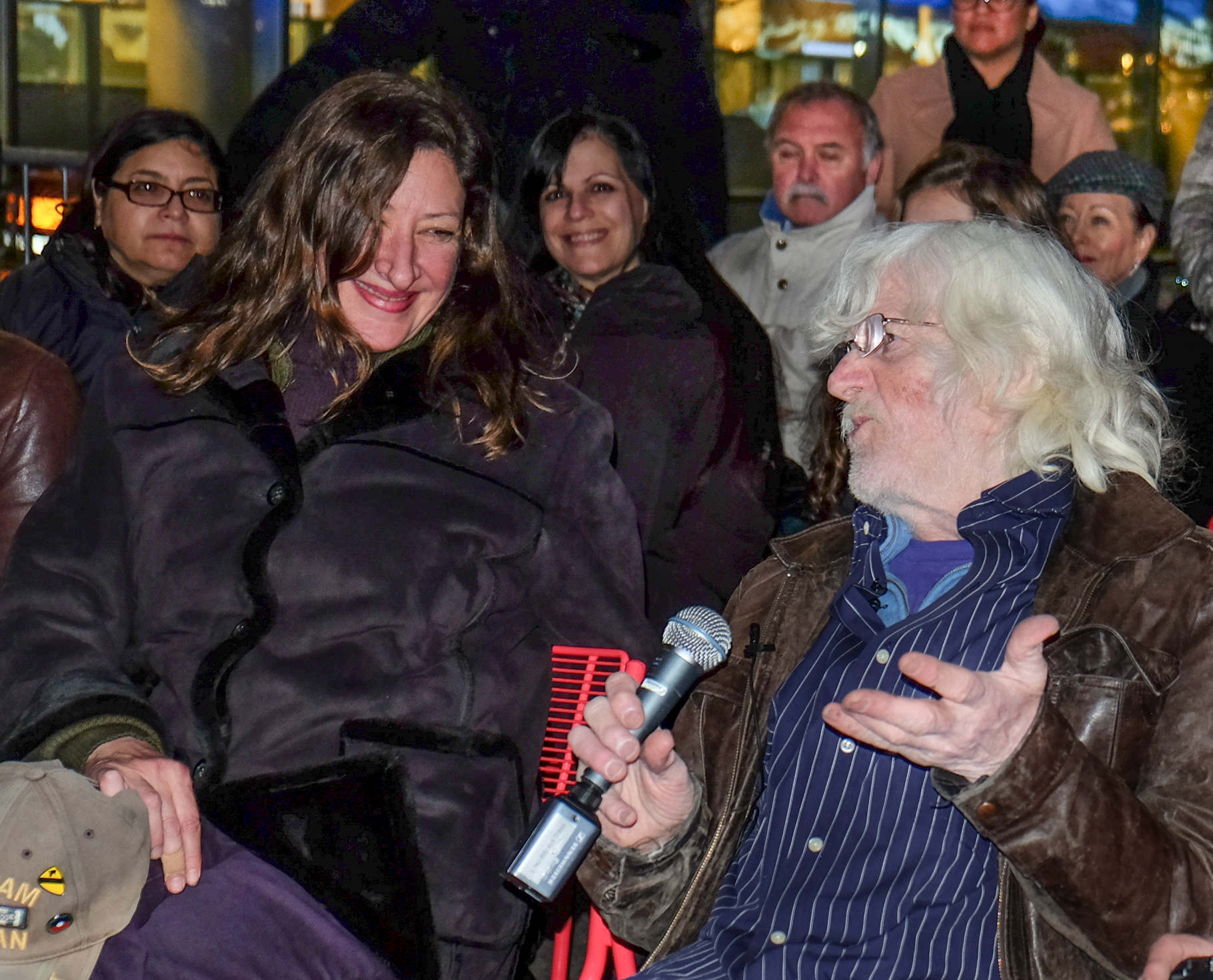
BY LINCOLN ANDERSON | Friends and supporters of street artist Jim Power gathered on Astor Place on a chilly afternoon earlier this month for the unveiling of the reinstallation of some of the “Mosaic Man”’s most high-profile light poles.
The city initially pulled these poles off the street for the Astor Place / Cooper Square renovation job, a major, multimillion-dollar project that only recently wrapped up. After some wrangling and negotiating, it was agreed that Power would fix up seven of the tile-and-glass-bead-encrusted poles.
Financing came from City Councilmember Rosie Mendez and the Village Alliance business improvement district, who both gave $9,000, plus $5,000 via generosity.com, a crowdfunding site. A few of the poles, which are nonfunctional, still need some final touches.
Power, 69, was born in Ireland, grew up in Queens and served in Vietnam. He has called the East Village home since 1981.
His work as a stonemason led him to start doing local guerrilla tile jobs. One of his first public works was repairing a pothole on the Astor Place subway island. He filed it with cement and tile shards. He also created imposing concrete tree-pit guards on St. Mark’s Place between Second and Third Aves., but the Fire Department deemed them too tall and demolished them.
Yet, people encouragingly told him, “Go up! Go up!” and soon he was embarked on creating his 80-lightpole “Mosaic Trail.” It’s been a 35-year journey, with many ups and downs.
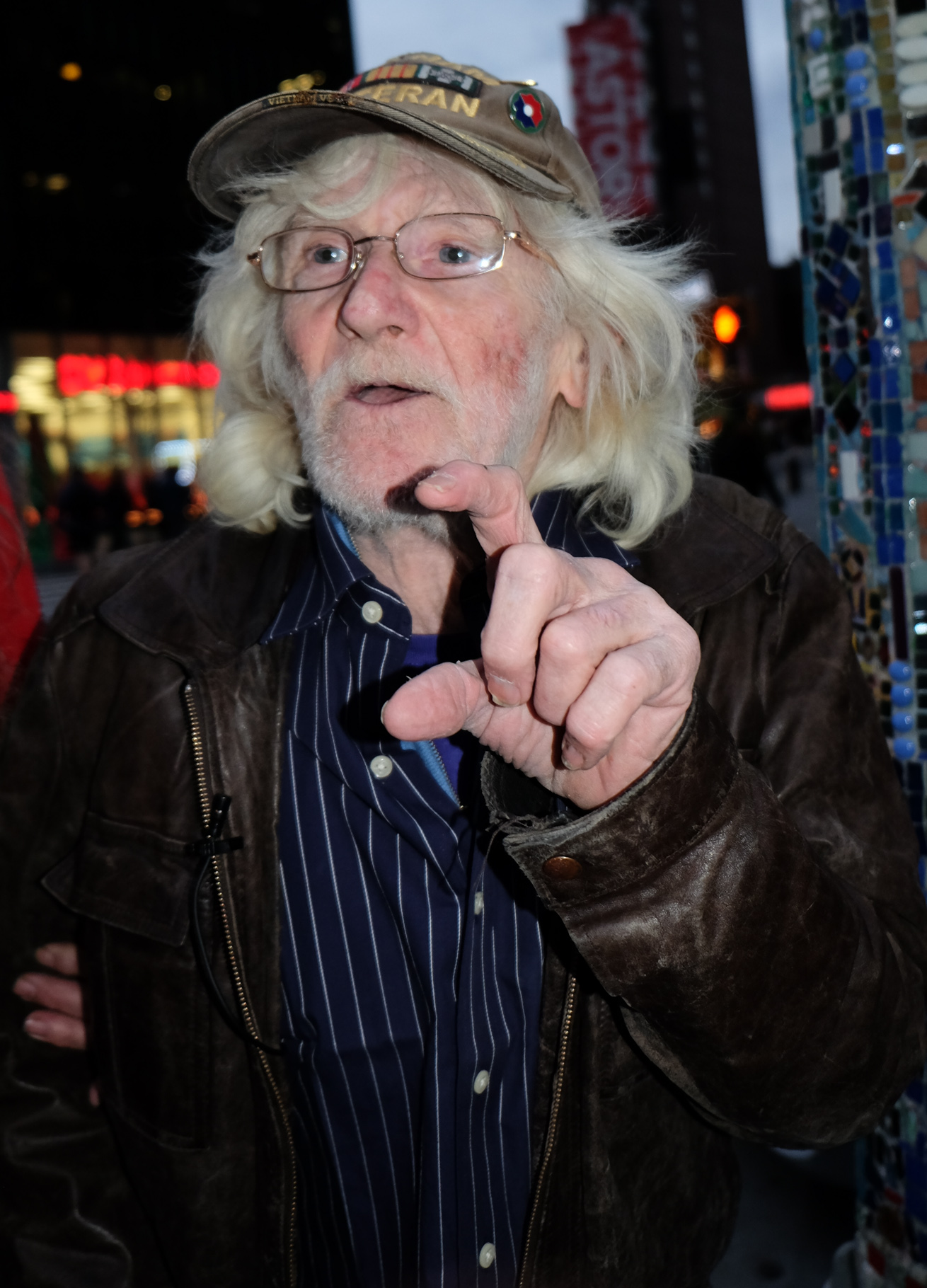
“We’re an acclaimed neighborhood,” Power said of the East Village and his poles’ role in celebrating it. “This neighborhood has retained that bubble for 200 years, since Day One.”
The artist is not shy about promoting his own work.
“ ‘The Cube’ is — call it what you will — it’s iconic,” he conceded. “But ‘The Cube’ didn’t make this neighborhood. My work made this neighborhood. I like to say I’m the longest-running show Off Broadway.”
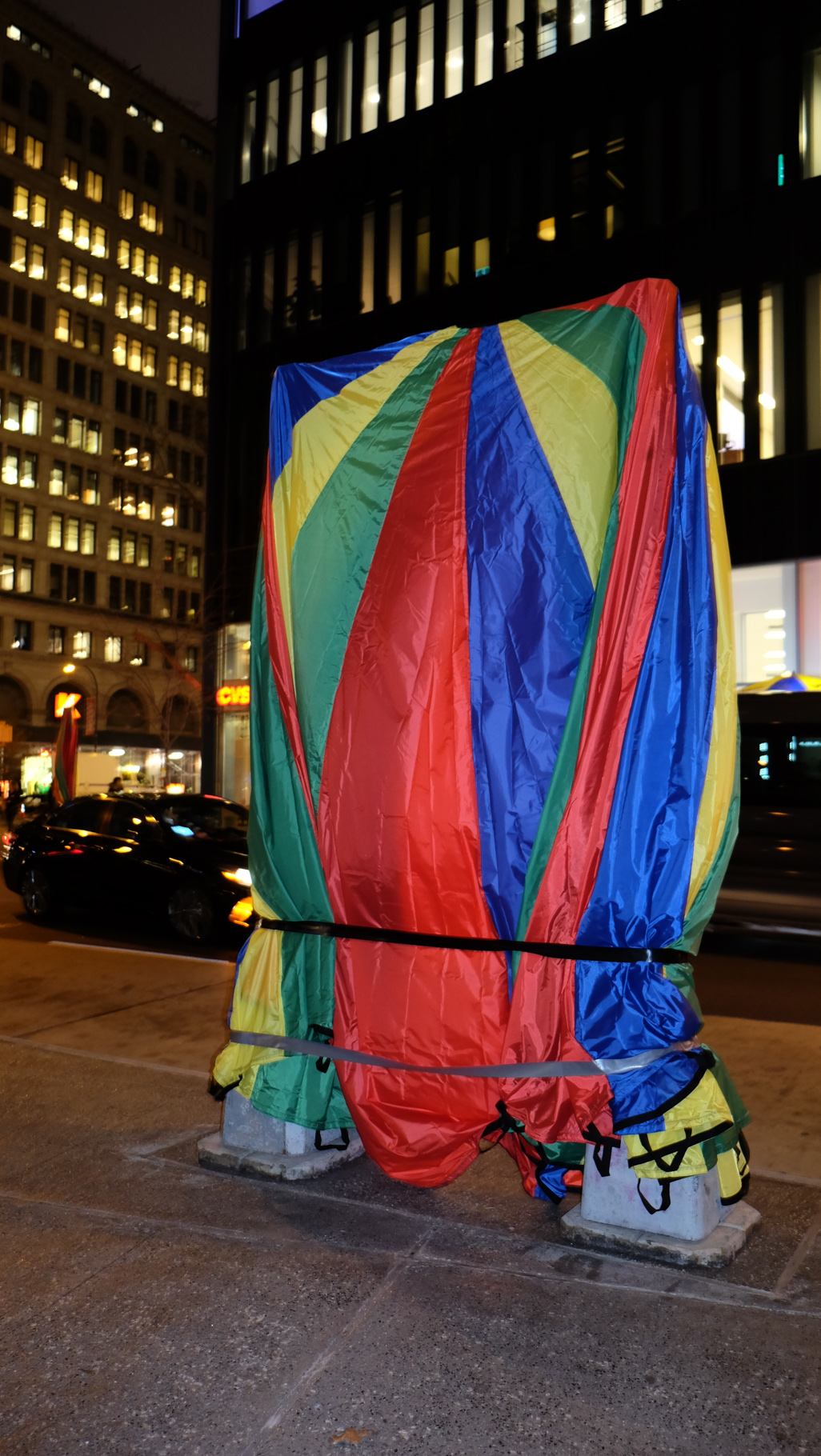
For a number of years now, though, Power has been in rough shape physically. He can barely move his painful hips, and needs a double hip replacement. For the past few years, he has gotten around on a tile-encrusted electric scooter.
A godsend to him on this latest project was local artist Julie Powell, who helped him renovate the poles and also kept him focused when the work hit rough patches and felt like it would never get finished. They toiled on the quirky street structures in the Sixth St. Community Center’s backyard, with only a tarp overhead to shield them from the broiling sun. Amid the pressure and the summer swelter, there were a few “Mosaic” meltdowns. The virtually disabled Power praised Powell for helping set him up with a foam pad under his knees and with his tools laid out nearby, which enabled him to do the work.
Powell, who formerly worked at Home Depot as a manager, even got the chain to fix up Power’s apartment at The Lee supportive housing on E. Houston St. under a free program it offers for veterans. Whereas everything formerly was jumbled together, they created a clearly defined workspace and a separate living space in Power’s apartment.
“We are thrilled to reach the culmination of three years of work on this project,” said William Kelley, executive director of the Village Alliance, which secured approval from the city to restore the Mosaic poles. “Jim’s works of art are integral to the neighborhood’s character and history, and now will be a part of Astor Place in perpetuity.”
In her remarks, Councilmember Mendez said, “Jim, thank you. I know this took longer and more time and you put your heart and soul into it again to make them more beautiful. This really goes back to what is the character of community. And Jim, you have been part of this community and you have enhanced its character and its history.”
Bob Holman of the Bowery Poetry Club was also among the speakers before Power led a tour of the poles. In 2007, he and Power co-taught a class about public art.
“He was the project,” Holman said. “He took the class on a tour of his work. We got to know what it’s like to be an artist with no support.”
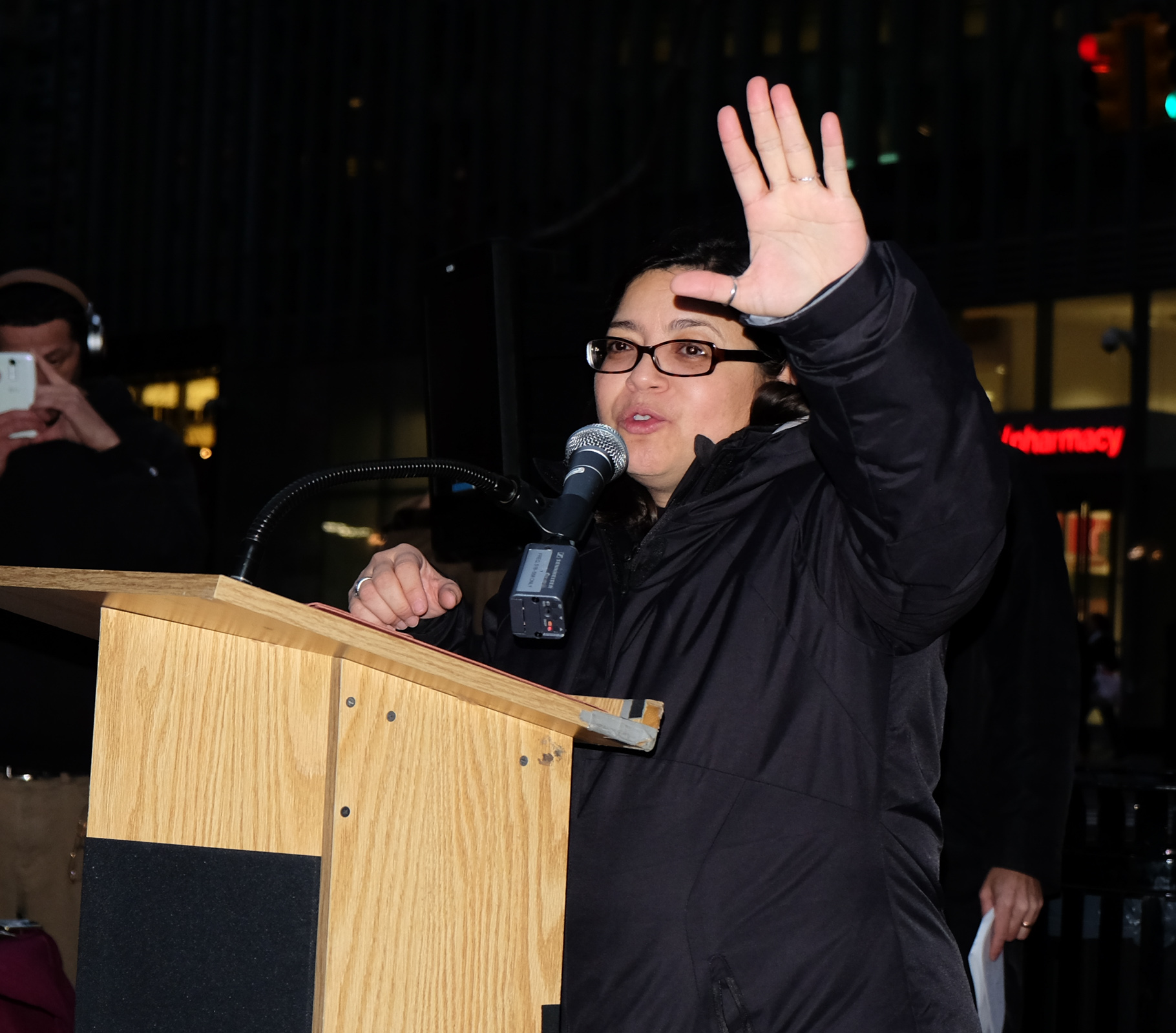
Steve Zeitlin, director of City Lore, the New York City “cultural heritage / folk-life nonprofit,” helped Power secure the workspace at the community center, allowing the lampposts to be returned from a city storage facility in Queens.
“Today, the poles, which prior to the renovation were often only partially finished, are complete and standing proudly, not as tiled lampposts but as totems,” Zeitlin declared. “The Directional Pole, which marks the directions to the adjoining neighborhoods; The Astor Pole, which tells the history of Astor Place and the nearby Public Theater; The Fire Pole, honoring the firefighters and first responders of Sept. 11; the Police Pole, with its new addition honoring the Ninth Precinct and the fallen officers; the Presidents’ Pole, honoring Presidents who spoke at the Great Hall at Cooper Union, including Lincoln; and the Art Pole, honoring artists from the East Village.”
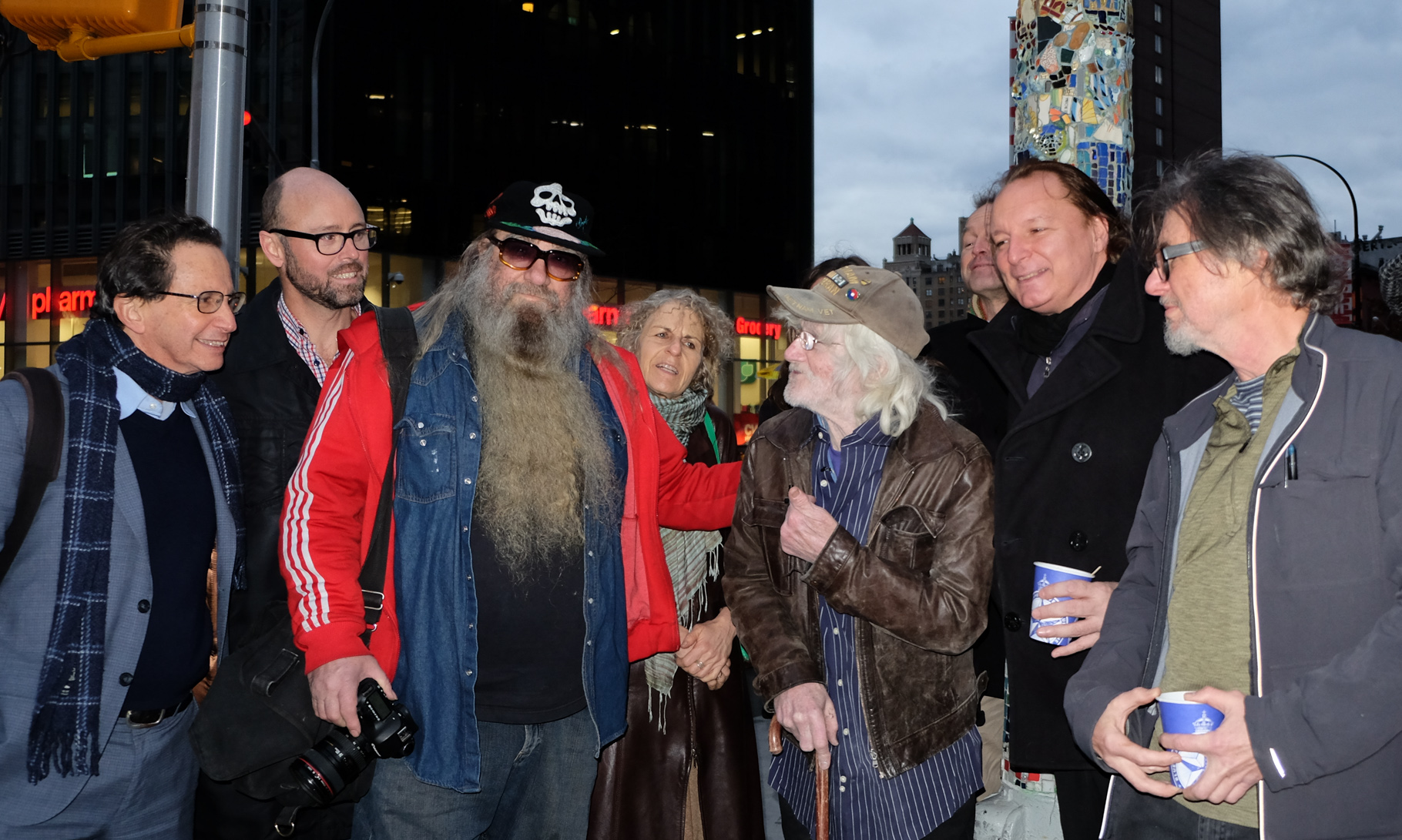
Zeitlin noted, however, that the project got off to a rocky start.
“When Jim heard that the poles were going to be restored, he started destroying them,” he recalled.
“He didn’t trust it,” chimed in Holman, adding, “He suffers from post-traumatic stress disorder.”
Basically, Power had been concerned that someone else — not him — was going to do the renovation work.
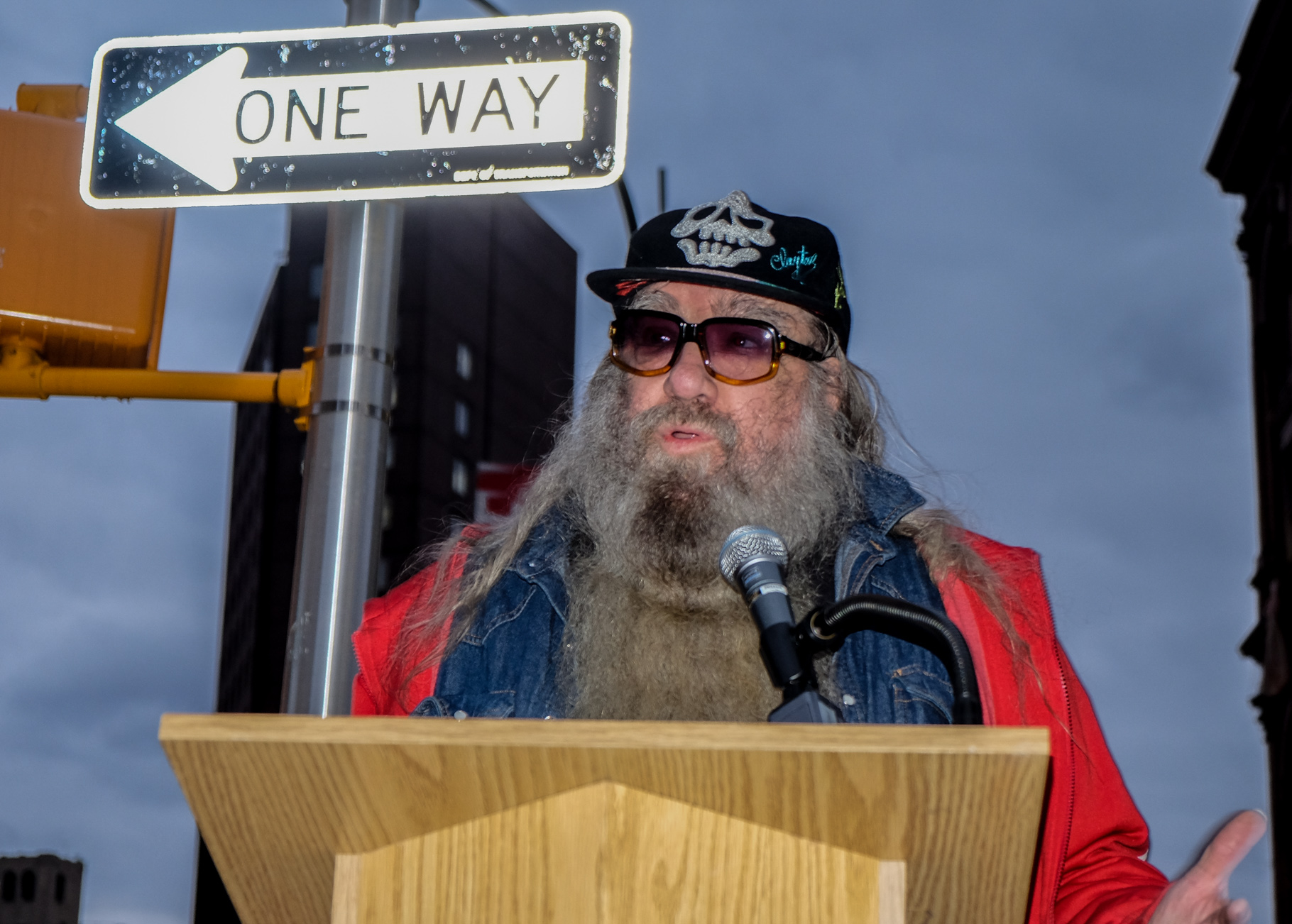
Also helping Power with the project was Clayton Patterson, the Lower East Side documentarian, who has covered the “Mosaic Man”’s doings over the years. Noting that Power’s poles laud local police and firefighters, even Bob Hope and the U.S.O., Patterson called on the likes of Donald Trump and Rudy Giuliani, in turn, to kick the artist some funding.
“Trump, Giuliani and all the Republicans — they all support the veterans, the cops, Fire Department and public servants,” Patterson said. “But really not one of them has ever supported Jim. Jim has given his life to do his mosaic work, to the point of being homeless and living on the street. Jim is a patriot, through and through. He is a Vietnam veteran.
“Trump’s son-in-law, a major East Village real-estate investor and landlord — like father-in-law The Donald and the others — all they do is take from the area,” he scoffed. “They don’t give back.”
Harry Bubbins, from the Greenwich Village Society for Historic Preservation, which also assisted Power, also spoke at the ceremony.
In an e-mail that a friend of David McReynolds shared with The Villager, the legendary socialist and peace activist noted that Power is one of the few people in the East Village he gives a dollar to when he sees him. McReynolds said Power is a character, for sure, “but does great work.”
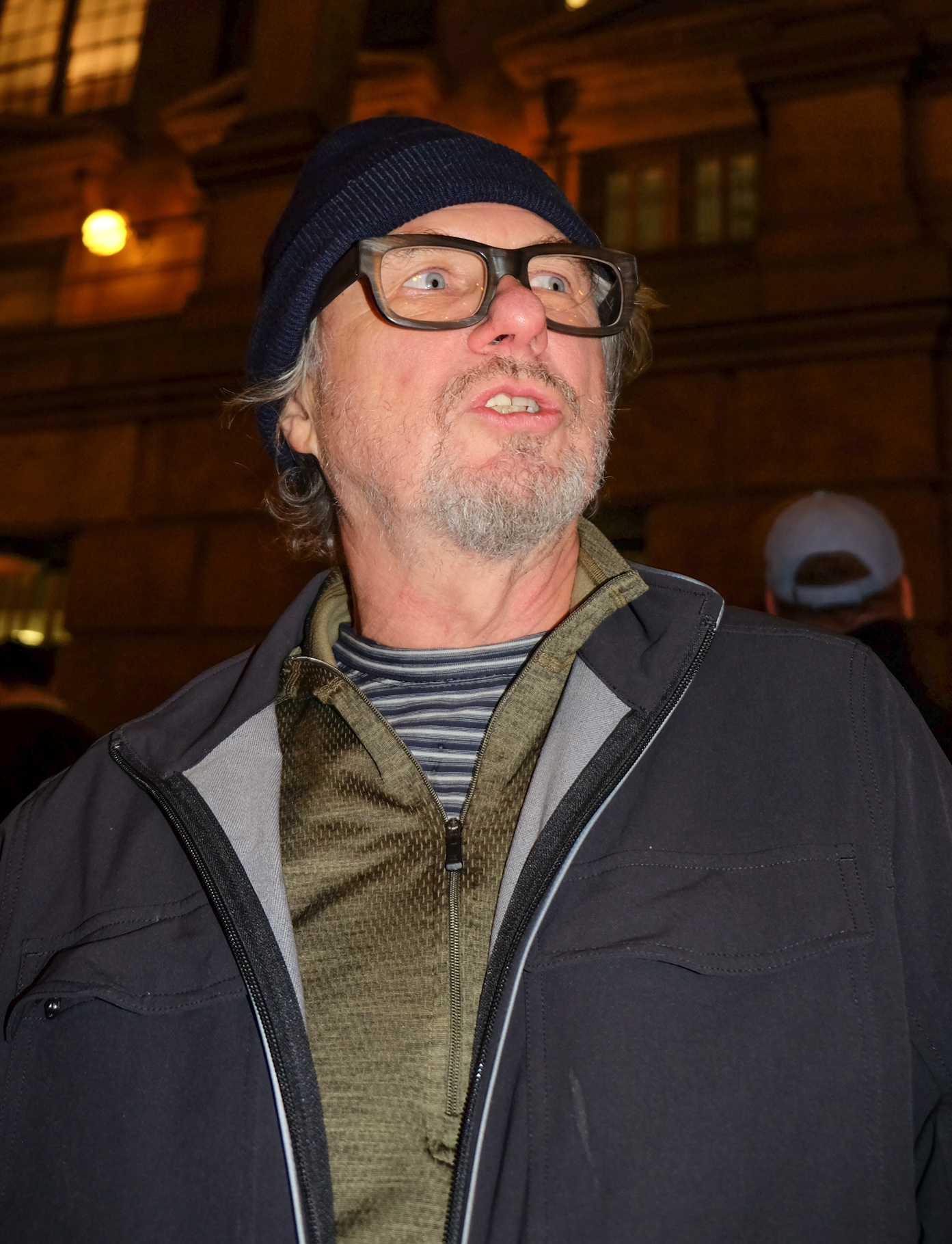
The “Mosaic Man” finally plans to get his double hip replacement sometime between April and June. As for his canine sidekick, Jesse Jane, 15, she’s ailing, too. “She needs wheels for her hind legs,” he noted.
Afterward, as Power scootered home along Astor Place, he pointed out some of his early work on the facade of the Khyber Pass Afghan restaurant. It featured lots of visible cement and larger pieces of pottery — yet, it still was a Power piece.
“All the elements are there,” he said.
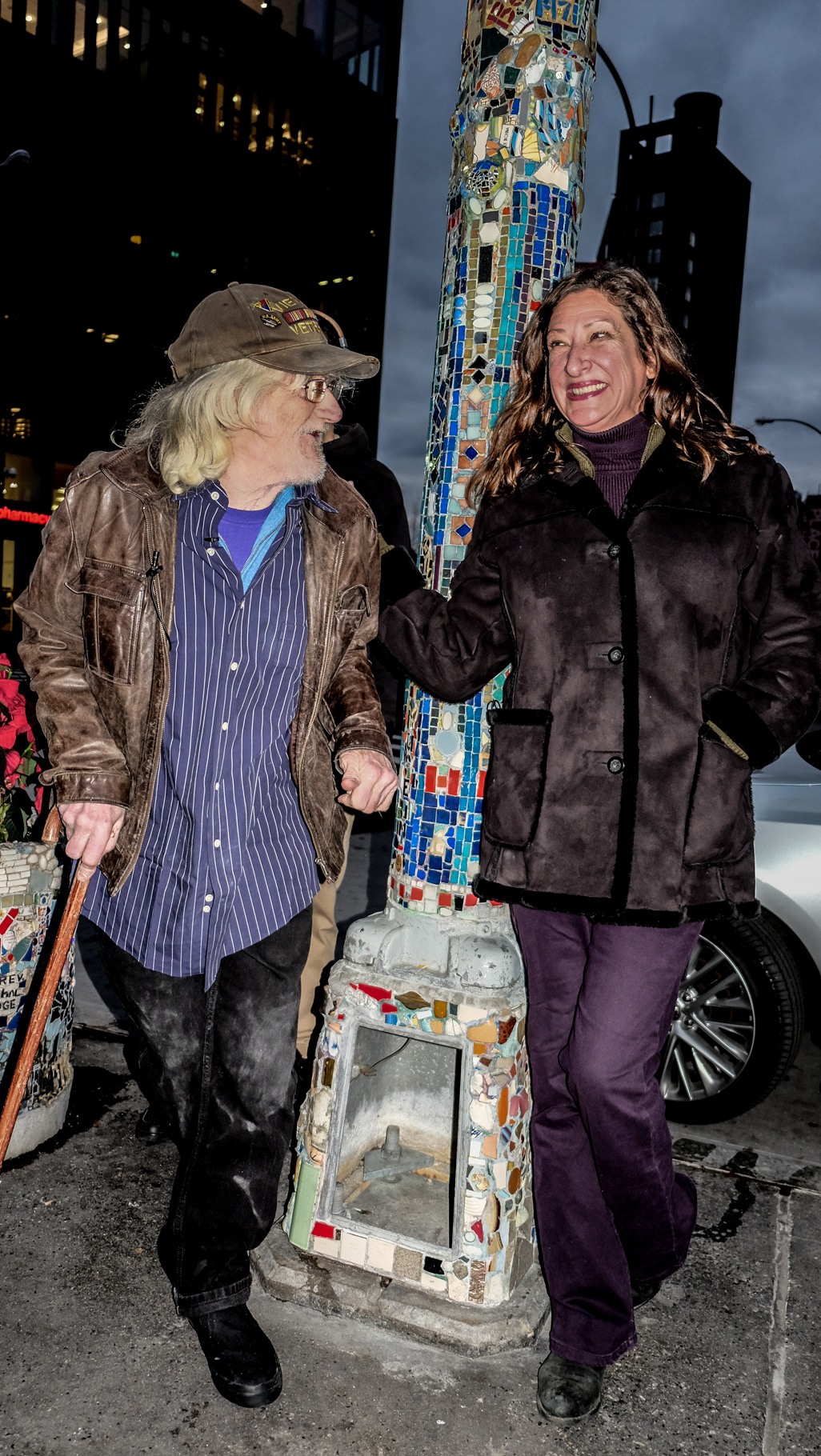
Over at The Bean, though, he paused to point out how some of the mosaic work was visibly deteriorating. He had some partners back then who tried to horn in on his business, but didn’t have his skills. The result is that the tiles have fallen off part of one of the sign’s letters.
“They didn’t put the glue on the wood first,” he said disapprovingly. “You have to put it on both surfaces.”
Meanwhile, Power has a paying commission job coming up at The Standard Hotel on Third Ave. Yet, he always is in need of more funding to finish the mythic Mosaic Trail. He felt he was underpaid for the Astor poles’ restoration and that, at times, also nearly derailed the project.
“The one on Second Ave. with the American flag — that took me six months to make,” he said of one of his other poles. “How can you put a price on that?”
In the late 1980s, according to Power, he had decorated 70 street lampposts, though many of them didn’t last. Based on the cost of labor, to do a new pole or renovate one is $12,000, he said. To do the full 80 and do the job right would require major funding.
He quickly crunched the numbers, then blurted out: “Make it 600 grand — is that killing anybody?”

















